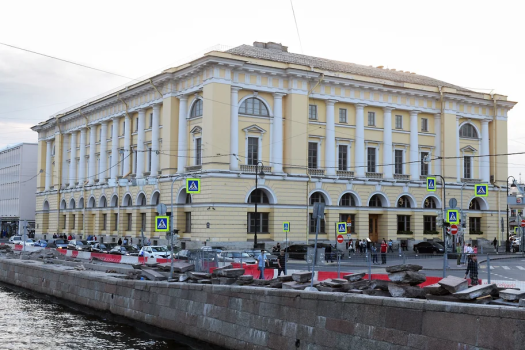To make history.
According to NF Group analysts, about 40% of new office spaces in class A and B will be delivered this year as a result of the renovation of existing historical buildings. Among such properties are the Ministry of Internal Affairs building on Fontanka, 57, and the premises of the former spinning and thread factory (PNK) at Krasnogo Tekstilshchika, 10–12. Experts confirm that in the context of a shortage of available land for construction in central locations, redevelopment and renovation of historical buildings remains almost the only way to adapt properties for commercial use.
In 2025, the market for office real estate in St. Petersburg is expected to see the completion of the construction and renovation of 15 buildings with rentable space of 135,000 sq. m. intended for office use, according to NF Group. Considering market practices, the construction and renovation timelines for several projects may be extended, and the actual increase in new office space this year may amount to less than 100,000 sq. m. Among the buildings under construction, only two belong to class A — “Nevskaya Ratusha” (corps 8 and 9), where all spaces were leased out even during the construction phase, as well as “Severnaya Palmira,” the majority of whose premises have also already been "booked." Among class B properties scheduled for delivery in 2025, the majority of the spaces (68%) are part of renovation projects, according to NF Group. The average size of these buildings is 3,500 sq. m.
Currently, several historical properties are being renovated for business centers, such as the Ministry of Internal Affairs building on Fontanka, 57, the corps of the spinning and thread factory at Krasnogo Tekstilshchika, 10–12, the card factory building at Obukhovskaya Oborona Avenue, 110b, the factory management building of a steel rolling mill on Vasilevsky Island, and others. “Ъ-SPb” confirmed the introduction of office spaces in the business quarter "Manufaktura 10/12" on Krasnogo Tekstilshchika Street (the "Bronka Group" project, management company – Might of Light). "This year, we are ready to commission 10,000 sq. m (phase one), of which about 2,000 sq. m will be allocated for restaurants and cafes, and 8,000 sq. m in loft style will be dedicated to offices and creative spaces," said Mikhail Kartavkin, CEO of Might of Light. According to him, the partners' plans include the implementation of the second and third phases of the project: organizing space for a nightclub and an open venue for events.
Regina Voloshchenko, Director of the Office Real Estate Department of NF Group in St. Petersburg, reminds that the share of renovation properties for office use in St. Petersburg has traditionally been high. "As of the beginning of 2025, only 59% of office space in class A and B are newly built, while 41% is renovation," notes the expert. Due to the lack of free land for development in the central part of the city, such buildings are attractive to developers. The minimal volume of new space entering the market in 2024, amid high demand, led to a decrease in the liquid supply of office real estate and a record low vacancy rate. In business centers expected to open in 2025, only 36% of the spaces are available (less than 50,000 sq. m), adds Ms. Voloshchenko.
Nelly Aleynikova, partner and director of the corporate services and sales department at Maris, believes that the redevelopment of historical buildings is a positive trend for the development of the office real estate market in the absence of new construction. "However, it is hard to imagine that the volume of renovation of historical buildings will significantly impact the vacancy rate," disagrees Ms. Aleynikova. "According to our data, developers have announced the delivery of about 120,000 sq. m of office real estate (rentable space) for 2025. Of these, only about 15% of office space can be attributed to the renovation of historical buildings." At the same time, the Maris expert agrees with the view that there is always high competition for premises among tenants in the central areas of the city, so renovation in the historical center will always be in demand.
Real estate market specialists share the observation that the "historical" factor of a building is not the top criterion among the factors by which tenants select suitable properties for offices. Location, rent rates, parking availability, public transport accessibility, and layout are still more important.
If a historical building has the status of a cultural heritage site, the tenant, under the lease agreement, must guarantee the compliance with protection obligations. Most often, the subjects of protection are the architectural appearance and facade decor, less often — spatial planning solutions and interiors of the property, notes Veronika Chakanova, partner and head of the office group at IPG.Estate. "The protection obligation is added to the lease agreement as an appendix. Otherwise, historical buildings that have undergone major renovation are suitable even for very demanding tenants," adds the expert.
"Our experience shows that offices in historical buildings are of interest not to low-margin businesses, such as clinics, banks, paid education, and corporate representations. There are certainly nuances in renting such buildings. These include preserving protective elements, layout, lack of parking, and the price per square meter. However, all these challenges are compensated by the unique atmosphere and spirit of the building," explains Olga Sharygina, vice president of Becar Asset Management.



